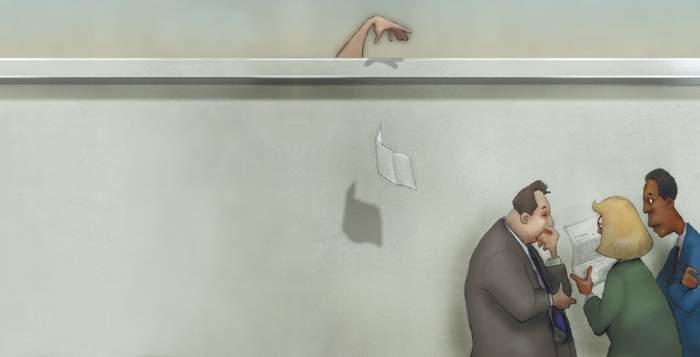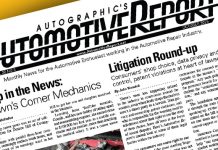By John Joswick
Imagine you’ve just boarded a flight to a training event you’re attending, and you strike up a conversation with the man or woman seated next to you. You ask what he or she does for a living and are surprised to learn they happen to work for one of the top 10 auto insurers. You mention that you work with that company on claims at your body shop, and the person tells you, “Oh, I’m the national claims manager for my company.”
Potentially for the next couple of hours, you have the ear of someone who can make the work your business does every day go smoothly and profitably — or be a day-to-day stressful struggle.
What do you tell that person?
That’s roughly the scenario posed recently to a variety of people in the industry: shop owners, shop association leaders, MSO executives, etc. Here’s what they said they would tell an insurance company’s national claims manager if given an opportunity to speak with them about ways to reduce costs, help shops be more efficient and improve the customer’s experience.
More information, please
Carroll Proctor is the second-generation owner of Proctor’s Collision in Augusta, Ga. He said he’d ask insurers to share more of the information they have about the claim up front.
“My shop manager and I both agree that one thing that would really be beneficial at the beginning of the repair process on DRP claims is to have more information,” Proctor said. “That may seem trivial, but to know all the facts and surrounding circumstances about how an accident happened, including customer statements made about the accident, could really make a difference. Instead of us having to make multiple calls to the insurance company, or asking customers questions they have already been asked and answered, we could eliminate those time-consuming conversations, thus allowing us to get the estimate written faster and reduce supplements.”
Proctor also would like insurers to help streamline parts processes by working with the industry to “weed out fictitious parts in the databases.”
“When sourcing parts from an aftermarket or LKQ vendor, there are often low-quality parts that are unusable or require repair time to make them usable,” Proctor said. “In addition, the part listed may be seven to 10 days away, and the vendor then tries to up-sell a more expensive part that can be available overnight. If the insurance companies could find a way to put some pressure on the vendors to remove these poor quality (or sometimes non-existent) parts from the databases, then repairs would move more smoothly.”
Parts are the key
Scott Benavidez of Mr. B’s Paint & Body Shop, Inc., in Albuquerque, N.M., agrees that parts decisions is an area where shops and insurers could both win.
“Parts decisions have been the biggest delays in our industry,” Benavidez, who chairs ASA’s Collision Division Operations Committee, said. “The decisions on who, what and where we get parts have been removed from the shops as part of insurance companies’ attempts to cut costs. But as an industry, we had built relationships with vendors we trust. We understand that, at least ‘on paper,’ parts can now be found two or three states away. But this does not mean that these parts are correct, or are in great condition. And the amount of time that the shops have in receiving the part, checking in the part, and then potentially having to send it back and start all over again can be significant. It leads to supplements, as well as to calls to the customer to explain that the parts that came in are in bad condition.”
Benavidez said trying to get credit for returned parts from rarely-used vendors possibly hundreds of miles away can be a challenge as well.
“We as an industry know that if an LKQ bumper cover from two or three states away is chosen, there is a 98 percent chance we will not be able to use it,” he said.
Insurers, he said, should let experienced shops order the right parts from the vendors with which they have trust and experience.
“It’s a key to customer satisfaction and reduced rental costs,” he said.
Bob Keith, a long-time owner of CARSTAR franchises and now the senior director of compliance and education for Assured Performance, says he, too, would talk to insurers about parts.
“Having a repair planner spend time sourcing multiple vendors for one part is not cost effective or efficient, and at times can create a negative customer experience,” Keith said. “The use of welded salvage assemblies or skins are extremely inefficient and drive costs up for the shop and efficiencies down for the technician. It’s also extremely difficult to do while following OEM procedures on today’s vehicles.”
Keith said this isn’t just an OEM vs. alternative parts issue.
“It’s about letting the repairer make the decision as to what is most cost-effective and timely for the vehicle and the consumer,” he said.
Eliminate some friction points
Aaron Schulenburg, executive director of the Society of Collision Repair Specialists (SCRS), said he’d focus his conversation with an insurance claims manager on areas that would “reduce friction at the field level.”
“I think one of those areas would be a mutual agreement that OEM repair procedures are the standard of repair,” Schulenburg said. “There are still lots of grey areas, a lot of places for discussion. But when there is a documented repair procedure or necessary step that the OEM has recognized, it would be valuable if that was an area that didn’t need to be debated or discussed or negotiated every time.”
Schulenburg said too often insurers acknowledge something is part of the OEM repair process but still tell shops, “We understand that’s a position, however, it’s not common in the marketplace so we aren’t going to recognize it.”
“I think if we could do away with those types of things, that would bring a lot of value to the industry and give the consumer a much better repair and claims experience,” Schulenburg said.
Segment the work
Paul Gange, president and chief operating officer of the Fix Auto USA shop network, said he’s talked with insurers about using more sophisticated processes early in the claim, when issuing assignments to shops.
“I think the model we’ve deployed in our industry for the past umpteen years, where literally everything is sent to a shop and sorted out there, is nonsensical and isn’t practical,” Gange said. “I really think we need to start looking at segmentation; things as simple as drivable versus non-drivable cars would be a place to start, segmenting those vehicles either to different [repair] centers or different kinds of work environments. By doing that, we can establish workflow and production processes in our shops that will allow us to repair vehicles more efficiently, and satisfy customers more effectively.”
Does Gange sense resistance from insurers to this concept, or is there just a lack of information and systems in place to do it?
“I see no resistance. I do see a technology limitation,” Gange said. “Insurers are massive companies that take a long time to deploy new technology. But I see a lot of carriers getting creative. We’re in a couple projects right now on this front.”
Work in collaboration
Michael Macaluso, president of CARSTAR North America, said he would push for increased collaboration.
“I come from an environment north of the [U.S.] border in Canada where it’s very, very collaborative,” he said. “All the problems we all tend to speak about are industry problems. So I’ve always taken a stance that industry problems need an industry solution. CARSTAR can’t solve all the issues. Neither can any other one company.”
Macaluso cited as one example of such collaboration in Canada an effort to work with several insurers on standardizing the first-notice-of-loss process and assignments coming into shops.
“None of that is really proprietary; it doesn’t give anyone a competitive advantage on the insurer side or on the consolidator side,” Macaluso pointed out. “We came together to streamline that process so it’s one less thing that’s different within a collision shop that we have to worry about. We’ve had some success with that. It just accelerates the start of the claim, which gives us all a chance to get the right result for our mutual customers.”
Set boundaries, but stay out of the details
Several of those who have shared what they would tell an insurance company’s national claims manager had a similar message to one another.
“One of the things I would push is for insurers to empower the shops to make the right repair choices,” said Barry Hadlock of Collision Works, which operates 10 shops in Kansas and Oklahoma. “If you’ve got a boundary or expectations, that’s okay, but let us work within those boundaries [rather than] dictate exactly how that repair is going to be consummated.”
Hadlock cites some insurers’ prohibition on shops scheduling in work on Thursdays or Fridays as an example of something that impacts efficiency.
“Open up the limitations on what I’m able to do,” he said. “We’re going to do the right thing to ensure the customer experience.”
Dan Risley, national executive director of the Automotive Service Association (ASA), echoed Hadlock’s message.
“I think it was Mike Ditka who said: ‘Let the managers manage. Let the coaches coach. Let the players play,’” Risley said. “For us, it’s, ‘Let the repairers repair the car.’ That doesn’t mean you don’t do oversight. But a less intrusive approach on the estimating and repair process would go a long way toward reducing overall friction and, likely, overall costs.”
Risley said he’d recently had a $15,000 homeowners claim after a water pipe broke in his basement.
“The Allstate adjuster called me and said, ‘Send me photos,’ then said to get a quote,” Risley said. “I submitted a quote, and they said, ‘Okay, we’ll have a check issued out tomorrow.’ Done. Over. They didn’t ask the contractor what sort of glue they were using or whether they were doing exactly what Allstate wanted them to do. They just paid for it and it was done. This was the best experience I’ve ever had with any claim. I don’t see why the same situation couldn’t play out on the collision repair side.”
You do your job; let us do ours
Tennessee-based Price’s Collision Centers has 11 shop locations, and company owner Bobby Price said his operation continues to grow despite not participating in insurer direct repair programs. His message to insurers basically boils down to: Stay out of our business.
“You sell insurance. We’ll fix cars,” Price said he’d say to that insurance claims executive. “I don’t tell you what to charge for insurance. Don’t tell me what I can charge to repair a car. Everything you do slows down the process, extending rental costs.”
Incomplete or poorly-written insurer estimates slow the process down by leading to wrong or poor quality parts being sourced, and multiple supplements being required, he said.
Instead, why not let the shop tear-down the vehicle and blueprint the complete repair; the insurer can come back out and approve it, and the whole process can continue without the stop-and-starts caused by multiple supplements. He said some insurers, such as Cincinnati, Chubb and Tennessee Farm Bureau, tend to operate that way.
“Those clams go through really smoothly and create really high customer satisfaction, and provide a high quality repair,” Price said.
“Is it not more important to provide that level of customer service to your policyholder, knowing that policyholder retention is most the important thing, and allow a shop to repair the car in a quality way, in the way you claim you want cars repaired,” Price said he’d ask insurance company executives. •
John Yoswick, a freelance writer based in Portland, Ore., who has been writing about the automotive industry since 1988, is also the editor of the weekly CRASH Network bulletin (www.CrashNetwork.com). He can be contacted by email at john@CrashNetwork.com.



